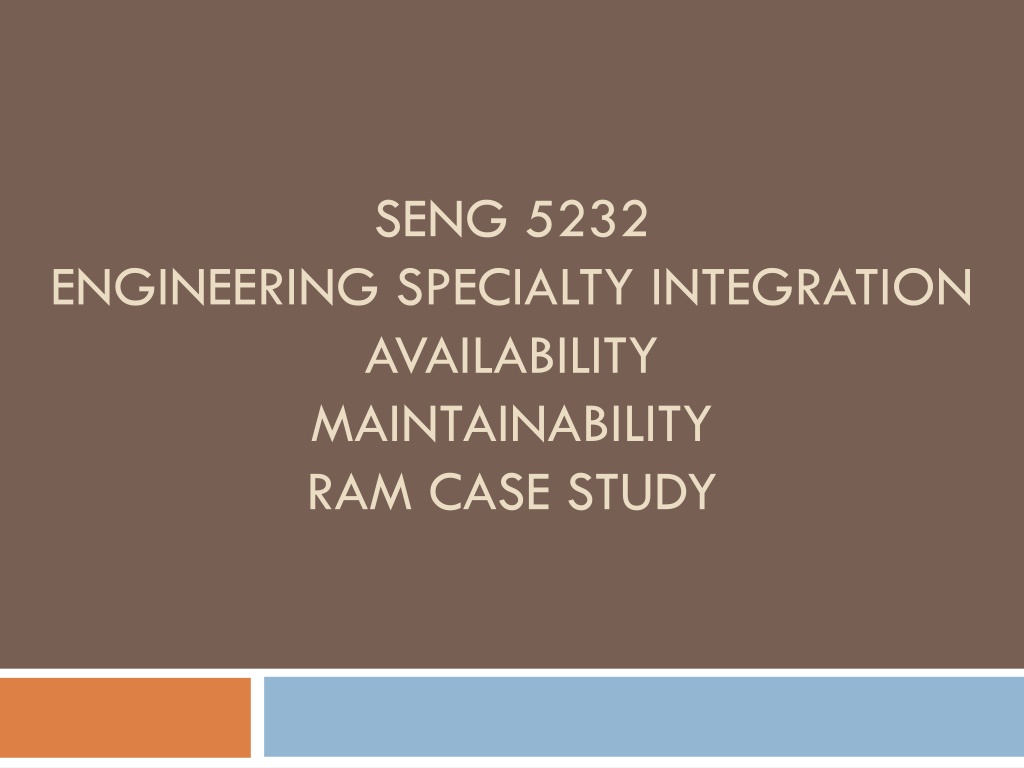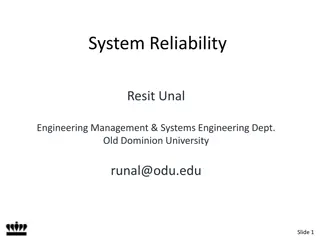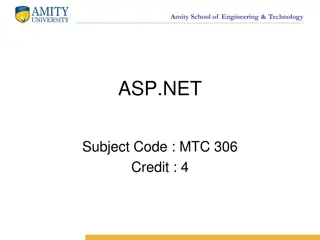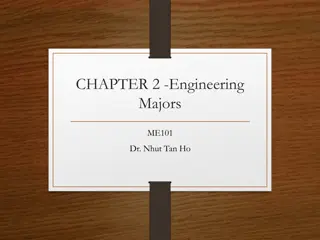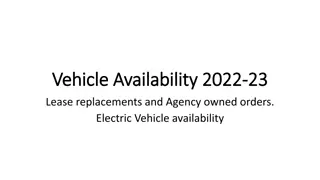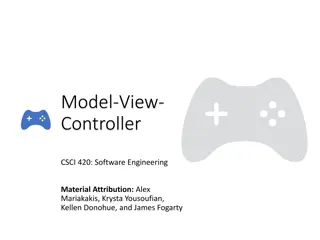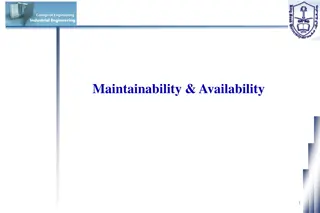Understanding Availability and Maintainability in Engineering
Availability and maintainability are crucial aspects in engineering, defining the system's operable state and its ability to fulfill missions. Availability is the probability of the system being operational when called for, contingent on factors such as failure occurrence, maintenance frequency, and repair efficiency. It necessitates a clear understanding of operational guidelines, maintenance policies, and supply system responsiveness. Availability metrics encompass factors like failures, reliability, maintenance resources, and personnel skills. The concept of availability is further categorized into three types: inherent, achieved, and operational. Inherent availability signifies the system's operational duration without maintenance, calculated using mean time between failures and mean time to repair.
Download Presentation

Please find below an Image/Link to download the presentation.
The content on the website is provided AS IS for your information and personal use only. It may not be sold, licensed, or shared on other websites without obtaining consent from the author. Download presentation by click this link. If you encounter any issues during the download, it is possible that the publisher has removed the file from their server.
E N D
Presentation Transcript
SENG 5232 ENGINEERING SPECIALTY INTEGRATION AVAILABILITY MAINTAINABILITY RAM CASE STUDY
Today Availability Maintainability RAM Case Study
What is Availability? Measure of the degree to which an item is in an operable state and can be committed at the start of a mission when the mission is called for at an unknown (random) point in time. Simple Translation: The probability that the system is operation or available at time t.
What is Availability? A function of: 1. How often failures occur and corrective maintenance is required 2. How often preventative maintenance is performed 3. How quickly indicated failures can be isolated and repaired 4. How quickly preventative maintenance tasks can be performed 5. How long logistics support delays contribute to down time.
Availability Requires a description of how the item/system is to be used. How item will be operated Maintenance policy Maintenance concept Adequacy and responsiveness of the supply system Affected by how often a system becomes unusable and how long it takes to restore
Availability Metrics Elements that determine availability Failures Inherent level of reliability built into the system Maintenance Corrective and preventative Length of time required Resources Maintenance personnel available Skill and K of personnel # and availability of spare/repair parts, support equipment, etc.
Availability Three types of availability Inherent Availability Achieved Availability Operational Availability
Inherent Availability Probability the system (when used properly) will operate satisfactorily for a period of time without maintenance Does not include preventative or scheduled maintenance AI = MTBF(MTBF + MTTR) 1 MTBF: Mean Time Between Failure MTTR: Mean Time To Repair
Achieved Availability Probability the system (when used properly) will operate satisfactorily for a period of time Preventative or scheduled maintenance is included AA = MTBM(MTBM + MAMT) 1 MTBM mean time between maintenance MAMT mean active maintenance time
Operational Availability Probability the system (when used properly) will operate satisfactorily for a period of time when it is called upon Preventative or scheduled maintenance is included AO = MTBM(MTBM + MMDT) 1 MTBM mean time between maintenance MMDT mean maintenance down time
Inherent vs. Operational Availability Measure Equation Factors MTBF + = Ai MTBF: Mean Time Between Failure MTTR: Mean Time To Repair MTBF MTTR Inherent MTBM = A MTBM: Mean Time Between Maintenance MDT: Mean Downtime 0 + MTBM MDT Operational
Availability, Simplified Availability is measured in terms of uptime and downtime. Operational availability: Time during which system was capable of performing all required functions in a given interval Uptime 0= A Total Time Time during which system was supposed to be up during a given interval (Uptime + Downtime) Downtime Waiting for spare parts to arrive via supply chain (logistics downtime) Time to repair (maintenance time, queue for maintenance)
Question: Module 5 Exercise 5 Can a product with identical failures (rates and events) have different perceived or measured availability for different customers?
What is Maintainability? The probability that an equipment will be retained in, or restored to, a specified condition in a given period of time, when maintenance is performed in accordance with prescribed procedures and resources.
What is Maintainability? The probability that an equipment will be retained in, or restored to, a specified condition in a given period of time, when maintenance is performed in accordance with prescribed procedures and resources. Probability: Proportion (or % of the time) that a maintenance task is performed in a specified time. This probability will depend on?
Probability The way equipment is designed The tools available The skill of the person doing the repair The environment Technical manuals Ease of doing trouble shooting Getting access to the critical area Motivation of the person doing the repair
What is Maintainability? The probability that an equipment will be retained in, or restored to, a specified condition in a given period of time, when maintenance is performed in accordance with prescribed procedures and resources. Retained in, or restored to: Preventative or corrective maintenance. With either, the equipment is brought back to original condition.
What is Maintainability? The probability that an equipment will be retained in, or restored to, a specified condition in a given period of time, when maintenance is performed in accordance with prescribed procedures and resources. Condition: Original design level. Some degradation of system is expected, e.g. car.
What is Maintainability? The probability that an equipment will be retained in, or restored to, a specified condition in a given period of time, when maintenance is performed in accordance with prescribed procedures and resources. Time: Time it takes to perform the maintenance. Is a function of equipment design.
Time When equipment is designed, length of time maintenance is going to take must be considered. Average time to perform maintenance Maximum time to repair equipment (high probability) Ex: User of equipment may have a requirement that the equipment be designed so that Average repair time = 2 hrs 95% of all possible repair actions can be completed in 5 hrs Overall maintenance time will depend on?
Time Time it takes: Getting access to specific parts Diagnosing Repair or replacement Calibration Testing Closing up
What is Maintainability? The probability that an equipment will be retained in, or restored to, a specified condition in a given period of time, when maintenance is performed in accordance with prescribed procedures and resources.
Procedures Instructions and methods used to perform maintenance Manuals on how to perform maintenance Standard procedure for maintenance
Resources Skills of individuals performing maintenance Tools used Skill level and type of tool
Maintainability Metrics Quantitative Measures
Maintainability Metrics Mean Time to Repair (MTTR) Sample of repair actions Composite value, arithmetic average of maintenance cycle times for individual actions Aka Mean Corrective Maintenance Time ct M Maximum Active Corrective Maintenance Time (Mmax) Value of maintenance downtime below which one can expect a specified percent of all corrective maintenance actions to be completed.
Maintainability Metrics Mean Preventative Maintenance Time Mean Time to Restore System (MTTRS) For highly redundant systems, the average time needed to switch to a redundant backup unit Mean Downtime (MDT) Average time that a system is not operational due to repair or preventative maintenance (includes logistics and administrative delays) Maintenance Ratio (MR) Measure of total maintenance labor burden required to maintain an item M pt
Maintainability Engineering Formulas Maintainability Functions Mean Active Maintenance time = Failure Rate fpt = Frequency of Preventative Maintenance Logistics Delay Time (LDT) Admin Delay Time (ADT) ( )(Mct) + (fpt)(Mpt) M= + fpt
Categories of Maintenance Corrective Maintenance: Unscheduled actions as a result of failure Necessary to restore a system Troubleshooting, disassembly, repair, remove and replace, reassembly, alignment and adjustment Preventative Maintenance: Scheduled actions necessary to retain a system Periodic inspections, servicing, calibration, condition monitoring, replacement of designated critical items 1. 2.
Maintainability Measurables Time Labor Hours Maintenance Frequency Logistical Support Factors
Time Uptime Standby/Ready Time System Operating Time Downtime Active Maintenance Time System not active because of corrective and/or preventative maintenance activities Logistics Delay Time System not active because of logistics delays Administrative Delay time System not active because of administrative delays
Active Maintenance Time 1. Corrective Maintenance Preparation for Maintenance Localization and Fault Isolation Disassembly Repair Item Remove Faulty Item and Replace Reassembly Adjust, Align, and Calibrate Verification
Active Maintenance Time (cont.) 2. Preventative Maintenance Preparation Time Inspection Time Servicing Time Verification or Check out
Reliability, Availability and Maintainability (RAM) The Big Picture
DoD 5000 Series Acquisition Management Framework
Key Steps to Achieve RAM 1. Understand and Document User Needs and Constraints 2. Design and Redesign for RAM 3. Produce Reliable and Maintainable Systems 4. Monitor Field Performance
1. Understand/Document User Needs and Constraints Customer: operate, maintain, support capability being acquired Define desired capabilities to guide development Mission, system performance, structure, readiness, sustainability, constraints (logistics, affordability) Within capability, determine reliability, availability, maintainability needs of user Users, system/design/manufacturing engineers, testers develop RAM Rationale to establish boundaries and guidelines Consider interaction of system reliability, logistic support, operation Compare desired RAM levels to RAM performance of current systems, assess feasibility Translate operational RAM terms into contractual terms Provide reliability and maintainability incentives
2. Design and Redesign for RAM Objectives Develop comprehensive program for designing and manufacturing for RAM Develop conceptual system model (system, subsystem, components, performance requirements, etc.) Identify critical failure modes and degradations Use data from component-level testing to characterize distribution of times to failure Conduct analysis to determine if design is capable of meeting RAM requirements Design in: diagnostics for fault detection, isolation/elimination of false alarms
2. Design and Redesign for RAM Key activities 1. Implement the right activities at the right time in the right way 2. Conduct formal design reviews for reliability and maintainability 3. Use an impartial, competent peer for perform the design review 4. Use a closed-loop design review process 5. Emphasize systems engineering design analysis and rely less on RAM predictions 6. Fully understand the implications using COTS equipment
2. Design and Redesign for RAM Key activities 7. Focus on maintainability and provide sufficient resources to mature the diagnostic capability 8. Link design testing and reliability testing 9. Manage the failure mode mitigation process 10. Assess the risks and operational impacts before trading RAM for cost, schedule or other requirements 11. Address RAM considerations in pre-systems acquisition technology development activities 12. Avoid delaying corrective actions 13. Provide meaningful oversight in executing the contract
3. Produce Reliable and Maintainable Systems Focus now on process control, quality assurance, environmental stress screening Data provides insight on how well production units are performing in operational environment Testing Quality Assurance Achieving Initial Operational Capability 1. 2. 3.
3. Produce Reliable and Maintainable Systems 1. Testing 2. Quality Assurance 3. Achieving Initial Operational Capability
3. Produce Reliable and Maintainable Systems 1. Testing If system has satisfactory levels of RAM Purpose: learning Verify if problems from previous phases have been fixed, solutions incorporated.
3. Produce Reliable and Maintainable Systems 2. Quality Assurance Main RAM concern during manufacturing is to prevent degradation of inherent reliability, availability and maintainability design into system during design phase Quality & product assurance works with RAM team More on quality assurance next week!
3. Produce Reliable and Maintainable Systems 3. Achieving Initial Operational Capability Within lifecycle, units are receiving trained manpower, systems, equipment, support Working to achieve initial operational capability and operational availability Possible problems Inadequate maintenance training Unanticipated failure modes Differences in operational environment from anticipated during design RAM team should anticipate, monitor, identify resources to asses, resolve problems
Key Steps to Achieve RAM 1. Understand and Document User Needs and Constraints 2. Design and Redesign for RAM 3. Produce Reliable and Maintainable Systems 4. Monitor Field Performance
4. Monitor Field Performance Ensure that necessary levels of RAM are sustained during lifecycle Reliability and maintainability are drivers of support and cost of support Support Support equipment and tools Technical data Training and training support Computer resource support Facilities Packaging, handling, storage, transportation
